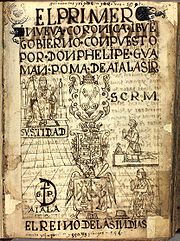
Nueva Crónica y Buen Gobierno
Encyclopedia

English language
English is a West Germanic language that arose in the Anglo-Saxon kingdoms of England and spread into what was to become south-east Scotland under the influence of the Anglian medieval kingdom of Northumbria...
: The First New Chronicle and Good Government), is a Peruvian chronicle finished around 1615. Its author, the indigenous Peruvian Felipe Guaman Poma de Ayala
Felipe Guaman Poma de Ayala
Felipe Guaman Poma de Ayala , also known as Guamán Poma or Huamán Poma, was an indigenous Peruvian who became disillusioned with the treatment of the native peoples of the Andes by the Spanish after conquest...
, sent it as a handwritten manuscript to King Philip III of Spain
Philip III of Spain
Philip III , also known as Philip the Pious, was the King of Spain and King of Portugal and the Algarves, where he ruled as Philip II , from 1598 until his death...
. His purpose was to give a historical account of the Andes from the earliest human beings to the Incas and the Spanish conquest
Spanish conquest of the Inca Empire
The Spanish conquest of the Inca Empire was one of the most important campaigns in the Spanish colonization of the Americas. This historic process of military conquest was made by Spanish conquistadores and their native allies....
; it was also meant as a call of attention towards the deep problems caused by Spanish government in the region. The manuscript was never published and its location for the next several centuries was unknown. The scholar Richard Pietschmann rediscovered it at the Royal Danish Library in Copenhagen in 1908; Paul Rivet
Paul Rivet
Paul Rivet was a French ethnologist, who founded the Musée de l'Homme in 1937. He was also one of the founders of the Comité de vigilance des intellectuels antifascistes, an antifascist organization created in the wake of the February 6, 1934 far right riots.Rivet proposed a theory according to...
published a facsimile edition in Paris in 1936. Some researchers believe that the manuscript traveled from Spain to Denmark via the library of the Count-Duke of Olivares, in Spain, part of which was sold to Cornelius Pedersen Lerche, ambassador of Denmark in Spain. Nevertheless, this is only a theory.
Content
The chronicle covers ancient Andean history, the rise of the Inca empire, the Spanish conquest in the 1530s, and early colonial society and government. Guaman Poma's discussion of Inca rule describes religion, social order, legislation, annual festivals and economic organization, as well as the functions of the different social groups. His narrative of Inca and pre-Inca times is often inaccurate according to modern understandings, but reflects how the Incas were remembered in the early colonial period, as well as Guaman Poma's distinctive ideas. Approximately half the book is dedicated to a description and harsh critique of Spanish colonial rule; scholars consider this section of the book as a uniquely valuable and reliable historical source. The book contains a large number of detailed illustrations which are often reproduced in books and articles about pre-conquest and colonial Peru. Guaman Poma dedicated the book to King Philip III of SpainPhilip III of Spain
Philip III , also known as Philip the Pious, was the King of Spain and King of Portugal and the Algarves, where he ruled as Philip II , from 1598 until his death...
, in the hope of improving colonial rule, but there is no evidence that the king ever saw the book.
External links
- "Guaman Poma - El Primer Nueva Corónica Y Buen Gobierno" – A high-quality digital version of the Corónica, scanned from the original manuscript.

